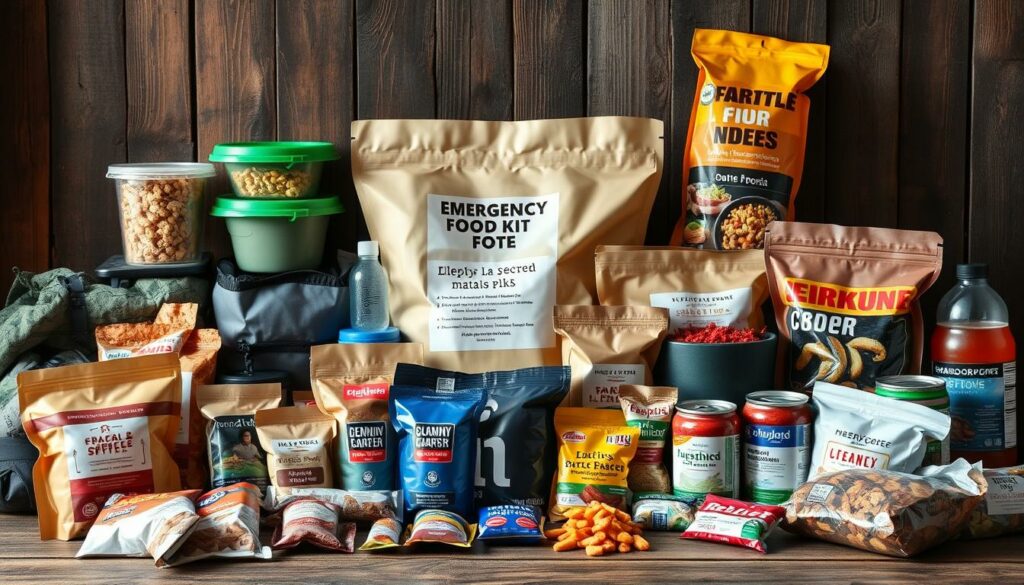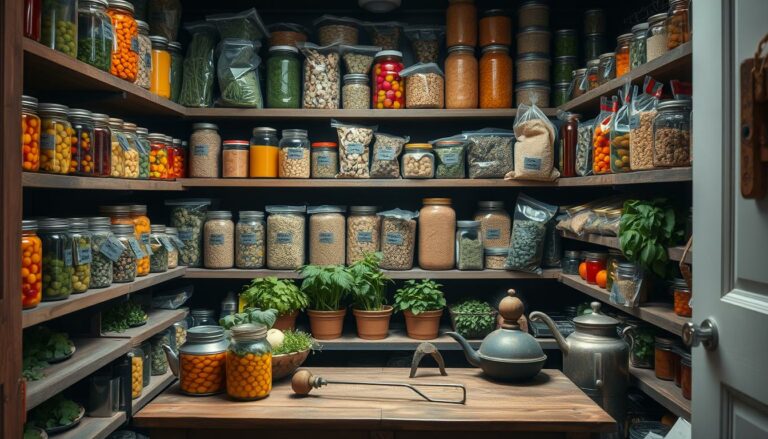In today’s world, natural disasters and pandemics are common. Mastering long-term food storage is key for preppers. It helps keep families safe and fed during tough times. This guide will show you how to store food for the long haul.
Key Takeaways
- FEMA recommends a minimum 3-day food supply for emergencies.
- The CDC advises having at least a 14-day food supply.
- Freeze-dried food can last up to 25 years.
- Proper packaging can preserve food for over 30 years.
- Understanding temperature and humidity control is vital.
- Canned foods typically have a shelf life of 2-5 years.
- Dried beans can last up to 30 years when stored correctly.
Understanding Long-Term Food Storage
Keeping your food safe and nutritious for a long time is key. It helps with food preservation, supports sustainable living, and boosts emergency preparedness. Knowing how to store food for the long haul is vital for preppers.
Why Long-Term Food Storage Matters
Long-term food storage is important for many reasons:
- Survival during emergencies: Having enough food during disasters, pandemics, or crises is critical.
- Cost savings: Buying food in bulk and storing it can save money over time.
- Supply stability: Storing food helps keep a steady food supply, even when the chain is broken.
- Sustainability: Reducing food waste helps the environment and supports sustainable living.
Benefits for Preppers
For those focused on emergency preparedness, long-term food storage has many advantages:
| Benefit | Details |
|---|---|
| Indefinite Shelf Life | Dry pantry staples like beans and pasta can last for years if stored right. |
| Food Security | A well-stocked pantry means no worry about food shortages in emergencies. |
| Hygienic Storage | Using proper preservation methods keeps food safe and free from contaminants. |
| Variety | Having a variety of storable foods ensures balanced nutrition and diverse meals. |
Common Myths Debunked
Many myths stop people from storing food effectively:
- It’s too expensive: While starting might cost, buying in bulk saves money in the long run.
- It’s complicated: Simple techniques and knowledge make food storage easy.
- Food quality degrades quickly: Keeping moisture below 10% and temperatures under 75°F (24°C) preserves food quality for decades.
Effective long-term food storage is key for preserving food and living sustainably. It greatly improves emergency preparedness.
Essential Principles of Food Storage
Managing food storage well is key to keeping food safe and fresh longer. It’s important to control things like temperature and humidity. This helps keep food good for longer.
The Importance of Temperature Control
Temperature is very important when storing food. Keeping food at the right temperature stops it from spoiling. It also slows down bad bacteria growth.
- Refrigerator temperatures should be maintained at or below 40° F (4° C).
- Freezers should be kept at 0° F (-18° C).
- During power outages, unopened refrigerators can keep food cold for approximately four hours, while fully packed freezers can maintain temperature for up to 48 hours.
“Foods with temperatures above 40°F for more than four hours should be discarded to prevent possible foodborne illnesses.”
Keeping the right temperature, even in emergencies, is key. It helps keep food safe and fresh for longer.
Managing Humidity Levels
Humidity affects how well food stays fresh. Too much humidity can cause mold and spoilage. Too little can dry out food:
- Use dehumidifiers in storage areas to maintain optimal humidity levels.
- Store foods in airtight containers to manage moisture control.
Keeping humidity in check is as important as temperature for keeping food fresh.
Understanding Shelf Life
Maximizing shelf life means watching food closely and storing it right. Here are some tips to keep food fresh:
- Regularly check and record refrigerator and freezer temperatures.
- Rotate stock using the “first in, first out” method to use older items first.
- Avoid storing foods at temperatures above 75°F (24°C) as it may reduce shelf life.
| Storage Condition | Recommended Practices | Impact |
|---|---|---|
| Temperature Below 40°F (Refrigeration) | Maintain fridge below 40°F; avoid frequent door opening | Slows bacterial growth; extends shelf life |
| Temperature 0°F (Freezing) | Keep freezer at or below 0°F for long-term storage | Halts bacterial growth; preserves food quality |
| Humidity Control | Use airtight containers; monitor store room humidity | Prevents mold growth; avoids food dehydration |
Following these food storage tips helps keep food safe and fresh. It also helps reduce waste and save money. Remember, good food storage is all about controlling storage conditions and maximizing shelf life.
Best Foods for Long-Term Storage
Choosing the right foods for long-term storage is key. You want a variety that’s nutritious. This way, you can avoid getting bored with your food choices. Here are some top picks for your emergency food stash.

Grains and Legumes
Grains and legumes are great for long-term storage. They’re affordable, easy to store, and full of nutrients. Here are some good ones:
- Rice and oats can last up to 2 years in airtight containers.
- Dried beans, lentils, and legumes can last forever.
- Corn starch has an indefinite shelf life if kept dry.
Canned and Freeze-Dried Options
Canned and freeze-dried foods are perfect for long-term storage. They last a long time and are easy to prepare. Add these to your collection:
- Canned fruits, vegetables, and beans can last up to 6 years.
- Packaged tuna has a shelf life of up to 5 years.
- Freeze-dried products from Valley Food Storage can last over 25 years.
Dehydrated Fruits and Vegetables
Dehydrated fruits and vegetables are nutritious and save space. They’re easy to rehydrate and packed with vitamins and minerals. Check out these options:
- Dried fruits can last a year; freezing extends their shelf life by 6 months.
- Dried pasta can last up to 3 years.
Protein Sources
Having various protein sources is vital for sustainable living. It helps keep your diet balanced during emergencies. Here are some good choices:
- Jerky can last up to 2 years if unopened.
- Powdered milk can last up to 20 years when stored right.
- Canned anchovies have a shelf life of about 1 year.
By stocking these foods, you’re ready for any emergency. Sustainable foods provide security and peace of mind. You know your family has the nutrients they need, whenever.
| Food Type | Shelf Life |
|---|---|
| Rice | 2 years |
| Beans and Legumes | Indefinite |
| Canned Vegetables | 6 years |
| Freeze-Dried Foods | 25 years |
| Dried Fruits | 1 year (plus 6 months if frozen) |
| Jerky | 2 years |
| Powdered Milk | 20 years |
Storage Methods and Techniques
Effective long-term food storage needs special methods and materials. These help keep food fresh for a long time. We’ll look at key methods like Mylar bags, vacuum sealing, and food-grade buckets.
Mylar Bags and Oxygen Absorbers
Mylar bags are great for storing food long-term because they’re strong and block out air. Adding oxygen absorbers makes the bag even better. It keeps dry foods like grains and legumes fresh for years.
Vacuum Sealing
Vacuum sealing is a top method for keeping food fresh. It removes air, which stops food from spoiling. Foods like dried beans and pasta stay good for a long time, making it perfect for preppers.
Using Food Grade Buckets
Food-grade buckets are strong for storing a lot of food. They work best with gamma lids to keep food safe from pests and moisture. Storing food in creative places, like under beds, saves space and keeps supplies ready.
| Food Type | Container | Estimated Shelf Life |
|---|---|---|
| Wheat | Mylar Bags with Oxygen Absorbers | 25-30 years |
| Corn | Vacuum Sealed | 10-15 years |
| Powdered Milk | Food Grade Buckets (Gamma Lids) | 12-24 months |
| Dried Beans | Vacuum Sealed | 10 years+ |
| White Rice | Mylar Bags with Oxygen Absorbers | 10-20 years |
In conclusion, using these advanced food storage methods can make your food last longer and stay fresh. This way, preppers can have a steady supply of nutritious food for years.
Creating a Long-Term Food Storage Plan
Planning your food storage is key to a lasting food supply for your home. It helps you meet nutritional needs, stay within budget, and keep your food organized.
Assessing Your Needs
First, figure out what your family needs to eat. Think about any special diets, allergies, or likes. A good rule is to have enough food for at least a month, aiming for three months in emergencies.
Buying non-perishable foods now can save money. Buying in bulk also cuts costs.
Setting a Budget
Creating a budget is important for managing your food storage. Start with a two-week supply and then increase to a month. While it might cost more to organize at first, it saves money in the long run.
Look for sales, buy in bulk, and focus on foods that last a long time.
Inventory Management
Keeping your food organized is vital to avoid waste and ensure food safety. Use the FIFO method to keep track of when you bought things. This helps you use older items before they expire.
Use airtight containers to keep pests out and store food in a cool, dry spot. Regularly check your pantry to avoid expired food.
Good food storage planning means less waste, fewer trips to the store, and saving money. A well-thought-out plan gives you peace of mind and protects your family in tough times.
Understanding Packaging and Containers
Starting a food storage plan means picking the right containers. They must keep food dry, pest-free, and fresh. Knowing your options is key for everyday use or emergency prep.
Types of Containers for Long-Term Storage
There are many good choices for long-term food storage. You can use glass jars, stainless steel containers, or food-grade plastic pails. Each has its own advantages:
| Container Type | Benefits | Drawbacks |
|---|---|---|
| Glass Jars | Airtight, non-reactive, transparent | Fragile, heavy |
| Stainless Steel | Durable, resistant to pests | Expensive, opaque |
| Plastic Pails | Lightweight, stackable, affordable | Permeable to gases, requires liners |
Labeling Your Supplies
Labeling your food storage is vital for keeping things organized. Write down what’s inside, when you packed it, and when it expires. This way, you can use the oldest items first and avoid waste.
Ideal Storage Locations
Choosing the right spot for your containers is important. Look for cool, dry, and dark places. These spots help avoid temperature changes and moisture that can spoil food. Try to keep your food under 85 degrees Fahrenheit to keep it safe and fresh longer.
Dealing with Pests in Storage
Pests can harm stored food, affecting long-term food plans for preppers. Knowing how to manage and prevent pests is key. This ensures your food stays safe and accessible.
Common Pests in Food Storage
Food storage pests include rodents and insects like weevils and moths. These pests often come from infested packages, like cereal and flour. Moisture also plays a big role in pest activity.
Prevention Techniques
To stop pests, keep storage areas clean. Regular cleaning is essential. Here are some ways to prevent pests:
- Proper Sealing: Use sealed containers like Mylar bags to protect food from pests.
- Freezing Flour: Freezing flour kills bugs before storage.
- Clean Storage Areas: Clean pantry and cellar areas to stop pests.
- Inspect Packages: Check for pest signs like wings and fecal droplets.
Effective Removal Strategies
Act fast if you find pests. In bad cases, get professional help. Here are some removal tips:
- Thorough Cleaning: Empty bins before use to avoid contamination.
- Moisture Control: Keep moisture levels low to stop pests.
- Professional Inspection: Regular checks help keep storage areas safe.
By using these prevention and removal tips, you can protect your food. This ensures a steady food supply for you and your family.
Rotating Your Food Supplies
Using the FIFO (First-In, First-Out) method is key to successful storage. It helps you avoid wasting food and keeps your supplies fresh. A consistent routine is also essential.
The FIFO Method Explained
The FIFO method is simple yet effective. It means using the oldest food first to prevent spoilage. This is very important for long-term storage, like canned goods that last at least 2 years.
Establishing a Routine
Having a routine for food rotation is important. Check your food every 6 months and replace near-expired items within 30 days. This reduces waste and keeps your supplies fresh. Don’t forget to check dry goods like rice and beans, which can last over 30 years.
Keeping Track of Expiration Dates
It’s vital to track expiration dates to avoid waste. Many preppers suggest using items within a year. Also, check storage conditions regularly. Ideal conditions are below 70°F (21°C) and humidity under 15%.
| Method | Expected Shelf Life | Recommended Check |
|---|---|---|
| FIFO | Varies (2-30+ years) | Every 6 months |
| Dry Goods | 30+ years | Every year |
| Canned Foods | 2-5 years | Every 6 months |
| Freeze-Dried Meals | 25 years or more | Every year |
Effective food rotation needs regular effort but is critical. It keeps your food safe and usable for a long time. By following these steps, you can reduce waste and improve your storage strategy.
Emergency Preparations and Food Storage
When emergencies strike, having both long-term and short-term food storage is key. Knowing the difference and how to prepare for each ensures your family is ready for any situation.
Long-Term vs. Short-Term Storage
Long-term storage is for keeping food safe for months. Foods like dried beans and rice can last up to 24 months. Short-term storage includes foods like canned fruits and veggies, lasting 12 to 24 months. Long-term foods sustain you during long crises, while short-term foods are for immediate needs.
Foods to Store for Emergencies
Choosing the right foods for emergencies is vital. Here’s a guide to help:
| Food Item | Optimal Storage Duration |
|---|---|
| Canned Fish | 18 months |
| Canned Potatoes | 30 months |
| Dehydrated Potatoes | 30 months |
| Canned Fruits and Vegetables | 24 months |
| Canned Fruit Juice | 24 months |
| Canned Vegetable Juice | 12 months |
| Pickles | 12 months |
| Jams and Jellies | 18 months |
| Dried Rice | 24 months |
| Cornmeal | 12 months |
| Dried Pasta | 24 months |
| Cold Breakfast Cereal | 12 months |
| Prepared Flour Mixes | 8 months |
| Packaged Dry Beans, Peas, and Lentils | 12 months |
| Canned Evaporated Milk | 12 months |
| Dry Milk Products | 24 months |
Planning for Power Outages
Being ready for power outages is key. Know that refrigerated foods stay safe for 4-6 hours. Freezer foods can last up to 48 hours. Make sure your emergency kits have non-perishable items like canned goods and dehydrated foods. Also, discard any perishable items stored above 40°F for 2 or more hours to avoid food-borne illnesses.

Maintaining Your Food Storage
Keeping your food storage in good shape is key to keeping food fresh and preventing spoilage. Regular checks, removing bad food, and following best practices help keep your food safe and fresh for longer.
Regular Checks and Maintenance
Regular checks and maintenance are vital for keeping food fresh. Make sure the temperature stays between 40-70 °F to stop food from spoiling. Store food in dry, non-humid places to prevent mold and bacteria.
Check containers for damage or pests to avoid infestations that can ruin food quality.
Dealing with Spoiled Food
Even with the best planning and storage, some food may go bad. It’s important to dispose of spoiled food safely to prevent it from affecting other food. Home canned foods should be eaten within 1-2 years, while commercial cans last longer but may lose quality.
Freezing canned goods is not recommended as it can lead to seam failure and foodborne illnesses.
Best Practices for Longevity
To make your food storage last longer, follow these best practices:
- Use FIFO Method: Use the first in, first out method to use older foods before newer ones, reducing waste and keeping food fresh.
- Choose the Right Containers: Use Mylar bags with oxygen absorbers, vacuum sealing, and food-grade buckets to extend shelf life.
- Monitor Storage Conditions: Keep temperatures stable and humidity low to prevent spoilage. The ideal maximum storage temperature is 75°F (24°C).
- Diverse Food Selection: Include a variety of foods from different groups such as grains, proteins (e.g., dried milk, canned fish), and dried/freeze-dried items to ensure a balanced diet during emergencies.
Lastly, keep your storage area clean and organized. This is essential in preventing problems and ensuring your food remains safe and edible for the long term.
Expanding Your Food Storage Skills
To get better at long-term food storage, keep learning and join in with others. Use books and workshops to learn new things. Websites like the National Center for Home Food Preservation are full of useful info.
Resources for Learning
There are many ways to learn about food storage. Books like “The Encyclopedia of Country Living” by Carla Emery are great resources. Workshops by groups like Extension Services give you hands-on practice. Websites focused on emergency preparedness and food preservation are also very helpful.
Joining Prepper Communities
Being part of prepper communities helps you grow in food storage. You can share tips and support each other. Online groups like Reddit’s r/preppers and Facebook groups are great places to learn and connect.
Keeping Up with Trends and Innovations
Food storage is always changing with new ideas. Staying current helps you stay flexible. Look out for new canning methods, better storage containers, and improved oxygen absorbers. This keeps your food storage up-to-date and effective.
Source Links
- https://practicalpreppers.com/diy-long-term-food-storage/?srsltid=AfmBOopAhAThu9-yfkbBSACFYFk3JHfgCoWqhQ8fLRgiP5oos8tV__JU
- https://natureofthenorth.co/basics/long-term-food-storage-methods/
- https://www.azurefarmlife.com/farm-blog/how-to-safely-store-food-long-term
- https://www.churchofjesuschrist.org/topics/food-storage/longer-term-food-supply?lang=eng
- https://www.fda.gov/consumers/consumer-updates/are-you-storing-food-safely
- https://mountainhouse.com/blogs/emergency-prep-survival/basic-emergency-food-storage-principles?srsltid=AfmBOopJX86ZZM28w-oKaRAPqUEq_DwmWFDB5gmniN_NBhfNsfA28fPA
- https://www.fooddocs.com/post/food-storage
- https://www.tasteofhome.com/article/long-term-food-storage-staples-that-last-forever/?srsltid=AfmBOoqqhiOj5UGQARlAvUnqEpf4wX3viEY1z8wB0wlr-UcEkRVKRfo5
- https://valleyfoodstorage.com/blogs/inside-vfs/best-long-term-food-storage-list-ideas?srsltid=AfmBOooKUw5dlJXisPmLqxy4S9iq0E1pAK-oshg6n1g1ItYiqL4jWf80
- https://gubbahomestead.com/homesteading/how-to-build-a-long-term-food-storage/
- https://www.fcs.uga.edu/extension/preparing-an-emergency-food-supply-long-term-food-storage
- https://www.mirasafety.com/blogs/news/guide-to-long-term-food-storage?srsltid=AfmBOopVg4y6RN7_p9JleiUS4b1ajShC1-Pg0-s0u35FAsfB8FhZkre9
- https://homesteadingfamily.com/building-up-your-long-term-food-storage-supply/
- https://beready.utah.gov/family-preparedness/12-areas-of-preparedness/food/
- https://www.mirasafety.com/blogs/news/guide-to-long-term-food-storage?srsltid=AfmBOopPm66aT1UUEvngFozKezEahk04VD9NQxIOpfVnwwFnpqsfZRpr
- https://www.caltexplastics.com/resourcess/how-to-store-food-for-long-term-storage-in-case-of-emergency/
- https://wallabygoods.com/blogs/food-storage-tips/how-to-protect-long-term-food-storage-from-bugs-pests?srsltid=AfmBOoquRR1-0rR26cawt512pIqzzNwFs1qJDBcTi8VPMePYksaU1TA4
- https://agcrops.osu.edu/newsletter/corn-newsletter/prevention-key-managing-stored-grain-pests
- https://www.sixfiguresunder.com/how-to-rotate-your-food-storage/
- https://packfreshusa.com/emergency-food-rotation-how-to-ensure-freshness-in-your-stockpile/?srsltid=AfmBOorHrs5EJBLuCBelHc461OpH11bsFvCVvXc9Jub1EgOowCI1fXHv
- https://extension.colostate.edu/disaster-web-sites/food-safety-and-storage-for-emergency-preparedness/
- https://www.fema.gov/pdf/library/f&web.pdf
- https://extension.colostate.edu/docs/covid/food-storage.pdf
- https://mountainhouse.com/blogs/emergency-prep-survival/basic-emergency-food-storage-principles?srsltid=AfmBOopBmB0WNICJBCoDNU945XPr8xVqSQVcMKn5sC9M_RA3mng5GZ_H
- https://www.theprairiehomestead.com/2021/09/how-to-store-a-years-worth-of-food-for-your-family-without-waste-and-overwhelm.html
- https://www.self-reliance.com/2015/02/basic-long-term-food-storage/
- https://www.uaex.uada.edu/life-skills-wellness/at-home-with-uaex/posts/food/long-term-food-storage.aspx

